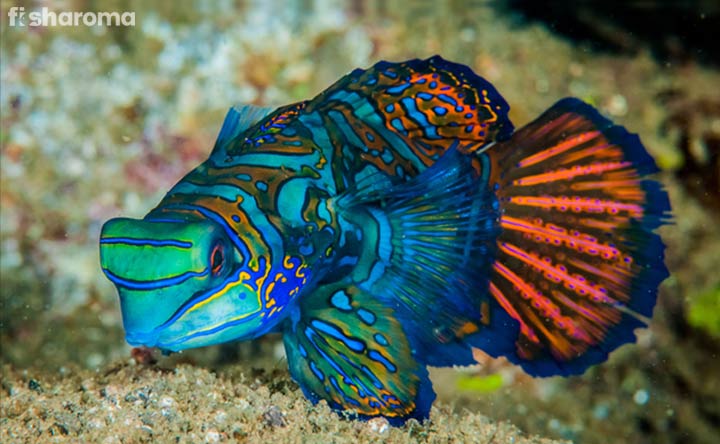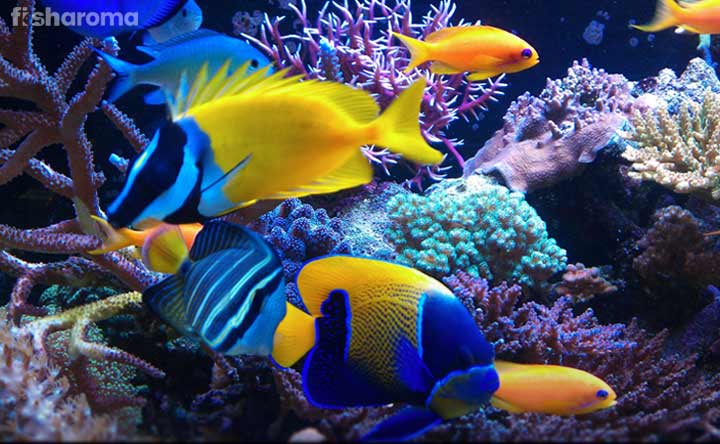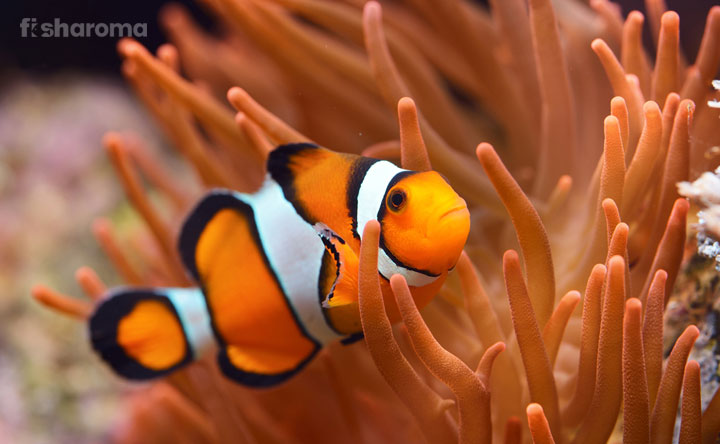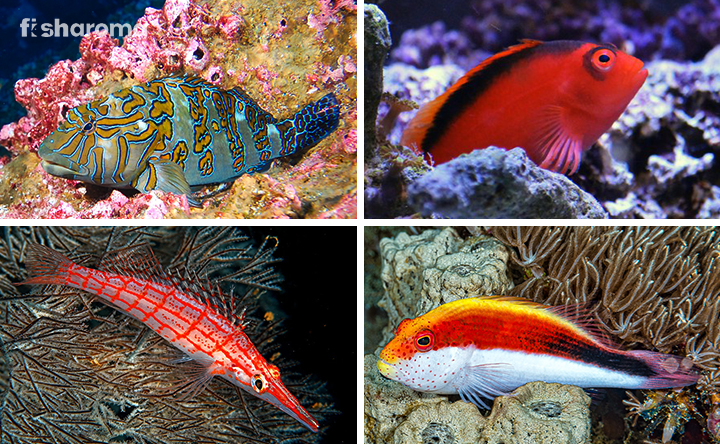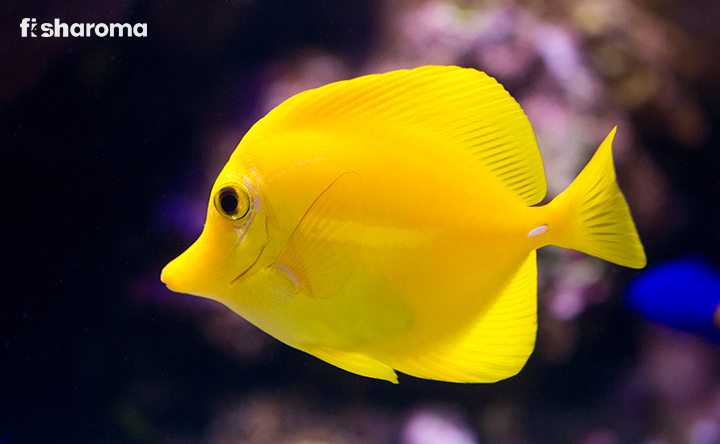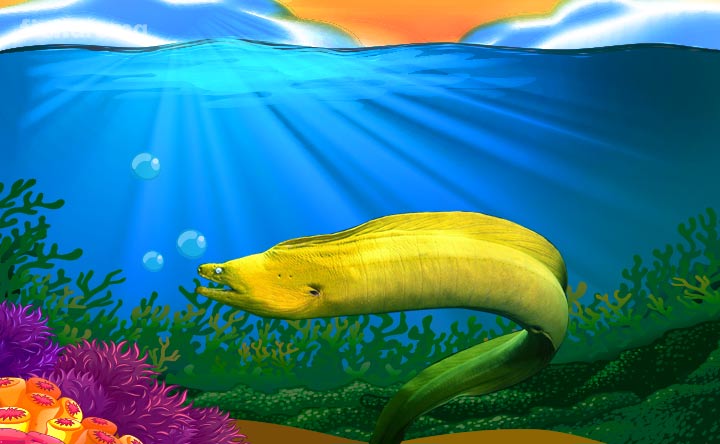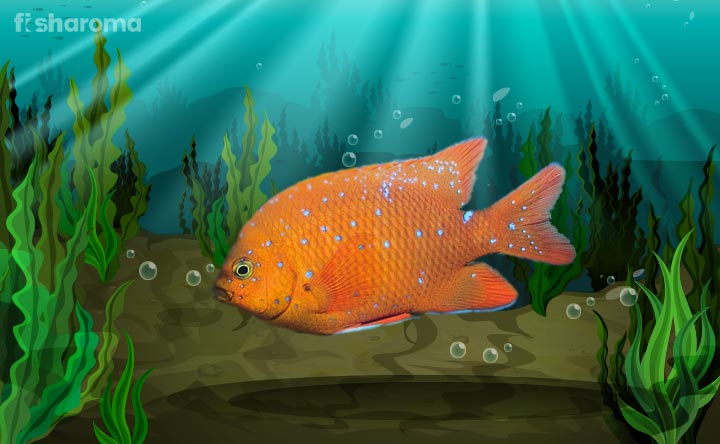Damselfish Care Guide – Breeding, Tank Requirements, Diseases & More
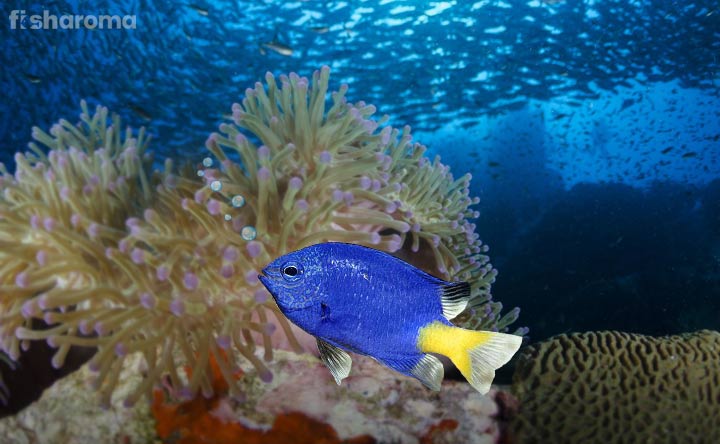
A highly sought-after choice of pet for aquarium enthusiasts, Damselfish is a saltwater species that has maintained its popularity over the years because of its hardy nature, small size, and easy availability. In fact, they are an ideal fish to start your fishkeeping experience with. But before you bring one home, go through our care guide so that you have a better understanding of their behavior and know the ‘Do’s and Don’ts’ you need to keep in mind for rearing them healthily at home.
Key Specifications of Damselfish
Before we breakdown each specific category, take a look into the key specifications of Damselfish.
| Scientific Name | Pomacentridae |
| Family | Pomacentridae |
| Origin | Tropical Coral Reefs |
| Size | 3-14” (7-36 cm) |
| Color | Multi-Color |
| Care Level | Easy |
| Lifespan | 5-6 Years |
| Temperament | Aggressive |
| Compatibility | Low |
| Tank Size | 30-Gallons |
| Diet | Mostly Omnivore |
Overview
Belonging to the Pomacentridae family, which in itself has over 350 species, Damselfish is a vibrantly colored species that spends the majority of its time foraging. This tropical fish is pretty active by nature, which is a great selling point for fish traders since people love to gaze the movements of fish in their tank.
Despite their aggressive personality, they are pretty easy to take care of. What is even better is the fact that they have multiple variants, each having distinct looks and quirks about themselves.
Origin & Habitat of Damselfish
Native to the Indian and Pacific Ocean, Damselfish are mostly found in tropical coral reefs. Although they are primarily a saltwater fish, a few of their variants live in brackish water and freshwater lagoons and some even in Mangroves such as the Freshwater Damselfish.
Some of their variants live in the warm temperate climates of Southern California and the Pacific Mexican coast, such as the Garibaldi variant. Few variants have also been spotted in the Caribbean area and the Atlantic Ocean as well.
While some variants live within the water column, others live in seagrass beds. Few variants also live at a depth of up to 100 m (328 ft).
Appearance of Damselfish
Different variants of Damselfish have different appearances. However, the primary structure and overview are of course same.
With a deep-colored body, a Damselfish sports a forked tail, similar to a Cichlid. They have a nostril on each side of their head along with two anal spines.
Size of Damselfish
Generally, Damselfish grows to a length of 3” (7 cm), but some rarer variants of this fish have been seen to grow to a length of 14” (36 cm) as well.
Color of Damselfish
Damselfish are known for their deep-colored bodies that can range anywhere between blue, red, yellow and orange. Some are even monochromatic in appearance, meaning they only come in black and/or white.
Behavior of Damselfish
To begin speaking about the behavior of a Damselfish, we need to state clearly and boldly that they are an aggressive fish. Not only are they notorious for bullying and intimidating shy, docile and peaceful fish, but they are also known to bite off the hands of their owners during feeding.
Their highly territorial nature forces them to claim a huge space, both in the wild and in captivity. Naturally, in the captive environment of a small aquarium, this huge space is mostly equivalent to an entire aquarium. They are extremely defensive of their territory and they feel threatened whenever someone else invades their space.
Larger Damselfish feed generally at the top of the water column whereas the smaller ones usually feed at the bottom of the column. One of its variants, the Domino Damselfish spends more than 85% of its time foraging.
Types of Damselfish
There are a bunch of types of Damselfish that differs from each other in sizes and colors, most of which are reared by fish enthusiasts across the globe. Some of the most popular variants among them are as follows:
Yellowtail Damselfish

Yellowtail Damselfish (Chrysiptera parasema) have a blue body and a distinct yellow caudal fin (tail fin). The pelvic fins of this fish are also yellow in color and in few cases; the color yellow is also extended to the back of their dorsal and anal fins as well.
They tend to grow up to a length of 3” (7 cm) and are deemed as one of the least aggressive variants of Damselfish. They generally inhabit the middle to bottom portion in a tank set-up.
Blue Damselfish

Blue Damselfish (Chrysiptera cyanea) are 3.3” (8.5 cm) in length and are bright blue in appearance. While the male members of this variant have a yellow snout and tail; the female members and the juvenile in most cases lack the yellow color. Instead, they have black spots on the base of the back edge of their dorsal fin.
Azure Damselfish

Azure Damselfish (Chrysiptera hemicyanea) is also known as Half-Blue Demoiselle since half of its body (the top portion) is bright blue in color while the other half (the bottom portion) is bright yellow in color. They are pretty hardy by nature and grow up to a length of 3” (7 cm).
Although they are less aggressive than Yellowtail Damselfish, they are hostile enough to stop you from keeping them with fish of other species. In a tank set-up, they inhabit the middle to the bottom portion of the tank. You will find them both swimming freely out in the open as well as hiding in crevices.
Bicolor Damselfish

Found in the Caribbean region, Bicolor Damselfish (Stegastes partitus) grow up to a length of 4” (10 cm) and is known for being particularly bony. They have the front part of their body in black/dark gray color and the rear part of their body in a pale color.
Domino Damselfish

The Domino Damselfish (Dascyllus trimaculatus) grows up to a length of 5” (12 cm). It is also known as Threespot Dascyllus because of the spots on its body. Having a distinct look from most of the other variants of Damselfish, it is extremely aggressive in nature. It is native to the Indo-Pacific region, mainly in the Red Sea, East Africa, Pitcairn Islands, Australia, and Japan.
Lifespan of Damselfish
The highly aggressive variants of Damselfish tend to live longer than the moderately aggressive ones. This fish can live up to 10-12 years, which is pretty long for an aquarium species. In fact, some variants of this fish can live up to 18-20 years. The rather unusual aspect of the lifespan of this fish is that they have been noted to live longer in captivity than in the wild. For instance, a few variants of Damselfish fish that live up to 10-12 years in captivity will live only up to 5-6 years in the wild.
Diet of Damselfish
Most of the variants of Damselfish are omnivore by nature, feeding on both live and frozen food as well as pellets and flake food. From live food to frozen food, from flakes to pellets, their diet is pretty diverse. However, it should be noted that some variants are exclusively herbivore, feeding only on vegetation.
Foraging takes up the majority of their time in the wild. While the smaller Damsels eat closer to the bottom of the water column, the larger ones eat higher up the water column. The speed of the water current also dictates where they forage. At a high-speed current, they forage closer to the bottom of the water column and vice-versa.
Damselfish also feeds on algae that grow in your tank, thereby acting as an algae-eater.
In a nutshell, the diet of a Damselfish should be rich in nutrients and a thorough research should be done before you buy a Damsel to find out whether it’s an Omnivore, Carnivore or Herbivore. Depending on it, you may feed your fish a diet that consists of the following:
- Zooplankton
- Mysid Shrimp (Both live and frozen)
- Bloodworms (Both live and frozen)
- Brine Shrimp (Both live and frozen)
- Vegetable Flake
- Clam
- Tiny Fish
- Squid Meat
- Algae
- Copepod
- Moss
- Pellets
The Damselfish in your tank may not eat all of the food mentioned here. Instead, a combination of the aforementioned food will become its primary diet.
Furthermore, this fish has a great immune system which allows it to consume different types of food without any consequences. That being said, their diet shouldn’t be taken for granted. A lack of nutrient would inadvertently result in their poor health.
If you are feeding pellets to your fish, please ensure you wet them before putting them into the tank so that air doesn’t get trapped in their digestive system. Similarly, please thaw frozen food before feeding them to your fish.
Feeding Cycle
Feeding your Damselfish thrice a day in small proportion is ideal since it will keep them less hungry, thereby reducing their aggression. Having said that, to regulate their aggression, don’t overfeed them.
Tank Requirements for Damselfish
Damselfish don’t need any fancy high-end set-up for surviving in a captive environment. As long as you are providing the basic environment in a clean manner, they will thrive. Here’s a lowdown on the basic things that you need to keep in mind for ensuring the good health of your Damsels.
Tank Size
Since Damsels are relatively small, a medium-sized aquarium would suffice. To be precise, for a single Damsel that is around 3” (7 cm) in length, a 30-gallon tank would be ideal. If you want to keep a pair of them, then you would need a 50-gallon tank. In case of a school of 4-5 of this fish, you would require a 100-gallon tank.
However, if you are keeping a larger Damsel in your tank that measures up to 12” (30 cm in length), then you would need a 100-gallon tank for a single fish.
Filter
Having a filter in your aquarium is essential since it helps regulate the quality of the water and also generate current that would reflect the similar condition as of its natural habitat. A canister filter is ideal in this scenario.
Ornaments
Go creative and include aquatic caves and rocks in the tank that houses your Damselfish. This is because although they love swimming in the open freely, they also require hiding spots.
Live rocks should also be added since it is home to numerous micro and macro-organisms that your Damsel can feed on. Besides, these rocks serve as a biological filtering system ensuring the tank stays healthy 24*7. In fact, live rocks should be the first thing added to a marine tank since they will help get rid of the ammonia from the tank.
Cleaning Method
Although Damselfish are algae-eaters in themselves, you also need to regularly clean your tank. Please remember that you can never use soap-based or other similar harsh chemicals to clean your tank since their residues are harmful to your Damselfish.
Water Type for Damselfish
Next up, you need to check the type of water that you put in your Damselfish tank. It goes without saying that since most of the variants of a Damselfish are saltwater species, you need to use marine water in the tank.
You can either directly buy them online or from a pet store or you can make saltwater at home by mixing Reverse Osmosis and/or de-ionized water with sea salt mix. Please do not mix table salt or any other salt to the water instead of sea salt mix because that might jeopardize the health of your fish. If your Damselfish is a freshwater or brackish water species, then you can just provide them with tap water.
The instructions that should be followed when selecting the type of water for your tank are:
Temperature
The temperature of the water in your tank has to reflect the temperature of the ocean water. It should be around 79-82° F (26-27° C). You can keep a thermometer in your tank to keep a watch on the temperature.
pH Level
The pH level of the tank water should be 8.1-8.4. To help maintain this level, conduct a pH test on a weekly basis with litmus paper or with other pH testing kits.
Specific Gravity
The specific gravity of the water should be 1.020-1.025.
Hardness
Make sure the carbonate hardness of the water in the tank remains at 8-12 dKH.
Replacement Procedure
The golden rule of water replacement in a tank is not to replace the entire volume of water in one go. This is because a sudden change in the water (even if all the parameters are kept the same) will create an ecological imbalance in the tank’s environment.
You can replace the water of your tank on a weekly, fortnightly or a monthly basis. If you plan to do it on a weekly basis, then you need to replace 10% of the tank’s entire water content. In case of fortnights, replace 20% of the water’s content, whereas if you decide to do it on a monthly basis, replace 30% of the water.
The new batch of the water that you add in the tank should have the same temperature, pH and hardness level as that of the old batch.
Compatibility of Damselfish
Damselfish are known for being hostile towards other species. It is advised to keep them with other species, only and only when you have an extremely large aquarium. Also, if you want to keep more than one Damselfish together, it is better if you keep same variants together.
Avoid keeping shy, docile or timid natured species with a Damsel since they always remain vulnerable to get bullied by the Damsels.
One great idea to make sure that your Damsel doesn’t claim the entirety of the tank is to introduce them last to your tank, after you have already let other semi-aggressive fish claim their territory. In this scenario, the Damsels would know which section of the tank is off-limits to them and would therefore not invade the territories of its tankmates.
Coming to invertebrates; although Damsels get along with them well enough, they are also known for eating them up. So, you need to keep a close watch or not take the risk at all.
Suitable Tankmates for Damselfish
In a large tank, you can afford to keep the following semi-aggressive fish with your Damselfish:
- Dwarf Angelfish
- Dottyback
- Clownfish
- Tangs
- Bottom Dwelling Gobies
Unsuitable Tankmates for Damselfish
Any peaceful temperament fish is a strict no-no for being kept together with a Damselfish.
Breeding of Damselfish
Damsels lay their eggs on the substrate, unlike most saltwater species that lay them on the water surface. There are many ways through which a male grabs the attention of a female. It can be through voracious movements, change of its color or even emitting clicking sounds. Once the female lays the eggs on the chosen nesting site of the males, protection of the eggs begin.
The males continue to protect their nest although they do display an extremely disturbing behavior known as filial cannibalism, in which, they consume the younger eggs so that they get the energy to take care of the more matured eggs. It’s their response to see the benefits coming from the eggs are warranting the cost of its parental care. Sometimes, they would devour dead eggs in order to stop the spread of the fungus that would affect the health of the other eggs.
The eggs take 3-7 days to hatch after which it drifts away as planktons, sustaining themselves by feeding on other phytoplankton and zooplankton. It takes around 2-3 years or even longer for them to mature, depending on the variant.
So, as you understand, breeding is tough and therefore, most people rely on buying them rather than waiting for new Damsels to born out of the existing ones. Nevertheless, you still can keep the males and females together and allow them to mate for their own health.
Damselfish Diseases
Probably the biggest reason for death or illness in Damselfish is due to a high exposure to ammonia over a long period of time. It leads to their body transforming to a dark color and/or spots on their tail and eventual death.
Do not use a Damselfish as the first inhabitant of the tank. Many people do it to establish the nitrogen cycle. However, it is strictly prohibited. Live rocks can do the same job for you. You don’t need to rely on a Damsel for this because it puts a lot of stress to their body.
Besides, they also are vulnerable to suffer from the following parasitic diseases as well:
- Marine Velvet Disease
- Marine Ich (White Spot Disease/ Crypt)
- Uronema Disease
Consult a marine veterinarian as soon as possible in these circumstances. Many people advise keeping the salinity of the water at a level of 1.010 for some time in order to kill off the parasites. However, this can’t go for a longer period of time since this low level of salinity will affect the fish’s health. Slowly and steadily, be sure to increase it to 1.020-1.025.
Interesting Facts about Damselfish
- Damselfish and Clownfish are considered cousins because they both belong to the Pomacentridae family.
- Blue Damselfish can change their color to black when they feel threatened.
- Lined Chromis (Chromis lineata) is the smallest variant of Damselfish, whereas Garibaldi Damselfish (Hypsypops rubicundus) is its largest variant.
- In some variants of Damselfish, the juvenile changes its colors as it grows and enters adulthood.
Summary
Hardy by nature and great to look at, Damselfish are an excellent choice of pet for your aquarium. As long as you are not obsessed with keeping multiple different kinds of fish in your tank, they will serve you good since they don’t bore well with intrusion from other species, owing to their aggressive nature. We hope our care guide has put you in a better position to take care of them. So, choose from their many variants and bring this amazing fish to your home.
Other Popular Fish for Your Aquarium
Interested in having other saltwater species in your aquarium? Take a look at the following guides:
- Mandarinfish: If you are looking for a peaceful saltwater species that will elevate the aesthetics of your tank, then Mandarinfish is the answer for you. Take a look at its care guide.
- Emperor Angelfish: Known for their eccentric movement and shimmering flat bodies, Emperor Angelfish are yet another beautiful addition to your tank. Learn how to pet this aggressive fish from here.
- Moray Eel: If going the unconventional route is your way, then this saltwater species is what you need in your aquarium. Only for those who dare, Moray Eel will is definitely not everyone’s cup of tea. But if it’s yours, then we are providing its care guide here.

